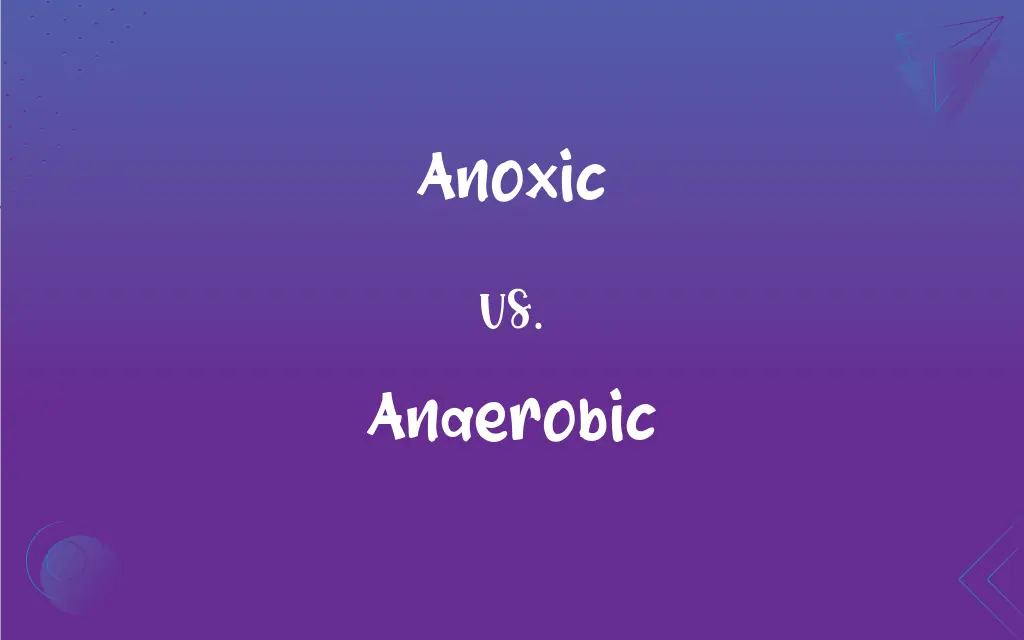Anoxic vs. Anaerobic: What's the Difference?
By Aimie Carlson & Janet White || Updated on May 29, 2024
Anoxic refers to environments lacking oxygen, while anaerobic describes organisms or processes that occur without oxygen.

Key Differences
Anoxic conditions refer to environments that are devoid of oxygen. These conditions are often found in deep water bodies or sediments where oxygen does not penetrate. On the other hand, anaerobic describes organisms or biological processes that do not require oxygen to function. Anaerobic bacteria, for example, thrive in oxygen-free environments and carry out processes like fermentation.
Anoxic environments result from the complete depletion of oxygen, making them inhospitable to most aerobic life forms. These conditions can lead to the accumulation of substances like hydrogen sulfide. Conversely, anaerobic conditions are typical in certain ecosystems, such as the gut of ruminants, where anaerobic microbes aid in digestion by breaking down complex molecules without oxygen.
Anoxic situations can arise from natural processes like stratification in lakes or human activities such as nutrient pollution, which increases biological oxygen demand. While anoxic conditions are detrimental to aerobic organisms, anaerobic conditions are essential for specific biochemical processes, such as in the production of methane by methanogens.
In aquatic systems, anoxic zones can lead to "dead zones" where most marine life cannot survive due to lack of oxygen. However, anaerobic processes are exploited in various industrial applications, such as anaerobic digestion in wastewater treatment, which helps in reducing waste and generating biogas.
Comparison Chart
Definition
Environment lacking oxygen
Processes/organisms functioning without oxygen
ADVERTISEMENT
Typical Environments
Deep water bodies, sediments
Animal guts, anaerobic digesters
Impact on Life
Detrimental to aerobic organisms
Essential for specific microbes
Resulting Conditions
Accumulation of substances like H2S
Methane production, fermentation
Examples
Dead zones in oceans
Anaerobic bacteria in intestines
Anoxic and Anaerobic Definitions
Anoxic
Lacking oxygen in the environment.
The bottom of the lake is anoxic, making it uninhabitable for fish.
ADVERTISEMENT
Anaerobic
Referring to biological processes occurring without oxygen.
The anaerobic digestion process produces biogas.
Anoxic
Characterized by the absence of dissolved oxygen.
Anoxic conditions in the reservoir lead to the buildup of toxic substances.
Anaerobic
Living or active in the absence of free oxygen.
Anaerobic conditions in the human gut aid digestion.
Anoxic
Referring to a state with no oxygen.
The soil becomes anoxic during heavy waterlogging.
Anaerobic
Involving processes that do not require oxygen.
Fermentation is an anaerobic process used in brewing.
Anoxic
Environments where oxygen is completely depleted.
Anoxic sediments are common in deep ocean floors.
Anaerobic
Pertaining to organisms that live without oxygen.
Anaerobic bacteria are crucial for sewage treatment.
Anoxic
Devoid of oxygen, especially in a biological context.
Anoxic water layers disrupt the aquatic ecosystem balance.
Anaerobic
Adapted to environments lacking oxygen.
Anaerobic microbes decompose organic matter in swamps.
Anoxic
Absence of oxygen.
Anaerobic
Living or occurring in the absence of free oxygen
Anaerobic bacteria.
Anoxic
A pathological deficiency of oxygen, especially hypoxia.
Anaerobic
Of or relating to anaerobes.
Anoxic
(pathology) Suffering from a reduced supply of oxygen.
Anaerobic
Without oxygen; especially of an environment or organism.
Anoxic
Lacking oxygen.
Anaerobic
Of exercise, involving glycolysis (the conversion of glucose to adenosine triphosphate) rather than using oxygen to supply bodily energy needs.
Anoxic
Of, pertaining to, or suffering from, anoxia.
Anaerobic
Of or relating to an anaerobe.
Anoxic
Greatly deficient in, or totally lacking, oxygen.
Anaerobic
Not requiring air or oxygen for life; - applied especially to those microbes to which free oxygen is unnecessary; anaërobiotic; - opposed to aërobic.
Anoxic
Relating to or marked by a severe deficiency of oxygen in tissues or organs
Anaerobic
Relating to, or like, anaërobies; anaërobiotic.
Anaerobic
Living or active in the absence of free oxygen;
Anaerobic bacteria
Anaerobic
Not aerobic;
Isometric exercises are anaerobic
FAQs
Can anaerobic organisms survive in anoxic conditions?
Yes, anaerobic organisms thrive in anoxic conditions as they do not need oxygen to survive.
What is the main difference between anoxic and anaerobic?
Anoxic refers to environments without oxygen, while anaerobic refers to processes or organisms that do not require oxygen.
What are some common anoxic environments?
Deep water bodies, sediments, and areas affected by nutrient pollution often become anoxic.
Can an environment switch from aerobic to anoxic?
Yes, environments can become anoxic if oxygen levels are depleted over time.
Can anoxic conditions occur in soils?
Yes, soils can become anoxic during heavy waterlogging, preventing oxygen penetration.
Can an environment be anaerobic but not anoxic?
Not typically, as anaerobic conditions imply the absence of oxygen, similar to anoxic conditions.
What are some examples of anaerobic processes?
Examples include fermentation and anaerobic digestion, both of which occur without oxygen.
Why are anaerobic processes important in wastewater treatment?
Anaerobic processes help break down organic waste and produce biogas, reducing pollution.
How do anoxic conditions affect aquatic life?
Anoxic conditions are harmful to aerobic aquatic life, often leading to "dead zones" where most organisms cannot survive.
Are all anaerobic environments also anoxic?
Yes, anaerobic environments lack oxygen, making them anoxic.
What industries benefit from anaerobic processes?
Industries like brewing, waste management, and bioenergy benefit from anaerobic processes.
How do anoxic conditions develop?
They develop due to the depletion of oxygen, often from natural stratification or pollution.
What substances accumulate in anoxic conditions?
Substances like hydrogen sulfide and methane often accumulate in anoxic conditions.
Do anoxic conditions always lead to the death of aerobic organisms?
Yes, aerobic organisms cannot survive without oxygen.
Why are anoxic conditions detrimental to most organisms?
Most organisms need oxygen for respiration and survival, making anoxic conditions uninhabitable for them.
What role do anaerobic bacteria play in human health?
Anaerobic bacteria in the gut help digest food and maintain a healthy microbiome.
What adaptations do anaerobic organisms have?
Anaerobic organisms have metabolic pathways that do not require oxygen.
How can we mitigate anoxic conditions in water bodies?
Reducing nutrient pollution and promoting water circulation can help mitigate anoxic conditions.
What is a practical application of anaerobic processes?
Anaerobic digestion is used in biogas production and wastewater treatment.
How do anoxic conditions affect chemical processes?
Anoxic conditions can alter chemical processes, leading to the accumulation of toxic substances.
About Author
Written by
Aimie CarlsonAimie Carlson, holding a master's degree in English literature, is a fervent English language enthusiast. She lends her writing talents to Difference Wiki, a prominent website that specializes in comparisons, offering readers insightful analyses that both captivate and inform.
Co-written by
Janet WhiteJanet White has been an esteemed writer and blogger for Difference Wiki. Holding a Master's degree in Science and Medical Journalism from the prestigious Boston University, she has consistently demonstrated her expertise and passion for her field. When she's not immersed in her work, Janet relishes her time exercising, delving into a good book, and cherishing moments with friends and family.































































